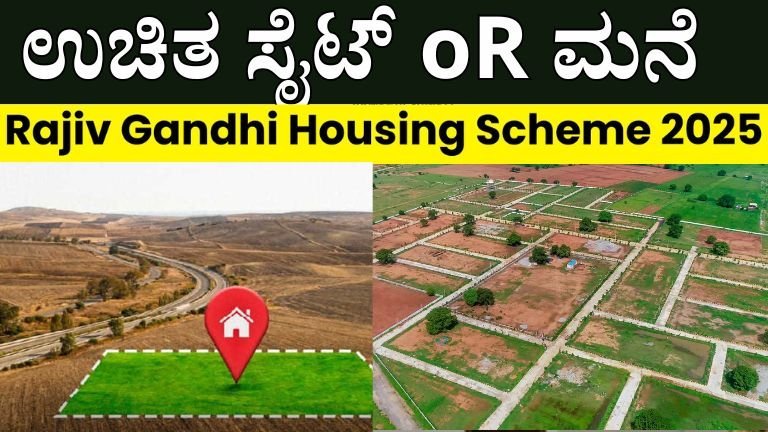Rajiv Gandhi Housing Scheme (RGHS) – Complete Guide for 2025
1. Introduction: Addressing Karnataka’s Affordable Housing Needs
The Rajiv Gandhi Housing Scheme (RGHS)—managed by Rajiv Gandhi Housing Corporation Limited (RGHCL)—is Karnataka’s flagship housing initiative aimed at economically weaker and marginalized communities. Established in 2000 under the state’s Housing Department, RGHCL continues to advance affordable housing for:
- Economically Weaker Section (EWS)
- Low-Income Group (LIG)
- Scheduled Castes (SC) / Scheduled Tribes (ST)
- Other Backward Classes (OBC)
- Homeless families and Persons with Disabilities (PWD)
RGHCL implements a range of schemes, including:
- Basava Vasati Yojana (rural EWS housing)
- Dr. B.R. Ambedkar Niwas Yojane (SC/ST houses)
- Ashraya Yojane (homeless family housing)
- Devaraj Urs Housing Scheme (OBC communities)
- High‑rise urban projects (“1 Lakh Homes” in Bengaluru)
2. Historical & Policy Context
Over two decades, RGHCL has targeted 706,290 houses for 2020–23, completing approximately 68,000 units, with many more underway . The 2025‑26 state budget injects fresh momentum—expanding urban high-rise housing and boosting rural schemes .
3. Key Schemes Under RGHS
A. Basava Vasati Yojana
Targets rural EWS households with home ownership, infrastructure, and sanitation links.
B. Dr. B.R. Ambedkar Niwas Yojane
Focuses on SC/ST families, offering subsidized housing with high-quality construction and minimally required contribution .
C. Ashraya Yojane
Supports genuinely homeless families through direct housing allotment and site development.
D. Devaraj Urs Housing Scheme
Aims for OBC inclusion with affordable houses at subsidized rates .
E. Bengaluru High‑Rise Homes (“1 Lakh Homes”)
Urban multi-story schemes offering more than 40,000 applications to date. Units are G+3 to G+14 structures, built with beneficiary support over time .
4. Target Beneficiaries & Eligibility
Primary eligibility rules include:
- Karnataka resident
- No existing pucca house anywhere
- Belongs to targeted category (EWS/LIG/SC/ST/OBC/PWD/homeless)
- Meets scheme-specific income criteria:
- EWS: < ₹3 lakh/year
- LIG: ₹3–6 lakh
- For high-rise urban projects, ability to pay the nominal beneficiary contribution (₹1–2 lakh)
Special allotment slots are reserved for women-headed households, manually-challenged individuals, and the homeless.
5. Benefits & Support Provided
RGHCL offers:
- Subsidized house units (direct allotment or construction support)
- Technical aid via housing designs and Nirmithi Kendras
- Site development (water, sanitation, roads)
- Soft loans or installment facilities where required
- Deposit support for beneficiaries in urban high-rises
6. Application & Verification Process
Step A: Online via Ashraya Portal
- Go to Ashraya.karnataka.gov.in
- Register with Aadhaar/mobile
- Choose scheme & region (urban/rural)
- Input data & income documents
- Upload proofs (caste, address, bank)
- Submit & receive a reference number
- Local body validation, site inspection, and computerized allotment
Step B: Offline Application
Available via:
- Local Gram Panchayats or Urban Local Bodies (ULB)
- Nirmithi Kendra support during camps and outreach events
Monitoring
Allotted beneficiaries gain access to:
- Geo-tagged progress tracking
- SMS/portal alerts
- Local site visits from officials
Completion certificates are issued upon final inspection.
7. Current Status & Ongoing Projects
Bengaluru City (1 Lakh Homes)
- Over 40,000 applications by March 2025; ~7,800 units completed, many in construction
Rural Housing
- Ongoing implementation of Basava & Ambedkar schemes across districts.
- Administrative push in Budget 2025 to speed up completion of backlog units
Financial Boost
- ₹500 crore allocated for pending houses and slum redevelopment projects
8. RGHS Challenges & Solutions
⚠️ Common Challenges
- Land acquisition delays in urban areas
- Deposits blocking beneficiary liquidity
- Administrative delays in design approvals and inspections
- Construction quality and delays
- Long waiting lists and slow allotment cycles
💡 Proposed Solutions
- Use non-disputed government land
- Introduce deposit payment plans or waivers for vulnerable families
- Streamline inspections using block-level monitoring tools
- Enforce third-party quality audits
- Conduct awareness drives boosting beneficiary applications
9. State & Citizen Outcomes
Positive Effects
- Asset creation within low-income families
- Improved housing standards with utilities
- Reduced informal tenancy and slum dwelling
- Social upliftment among Women, SC/ST, and the disabled
Areas to Monitor
- Deposit repayment rates and family affordability
- Completion pace in backlog units
- Quality and compliance of housing stock
10. Comparisons with National PMAY
The PMAY-U and PMAY-G (central) initiatives align well with RGHS. Local exclusives include:
- APC (Andhra/Telangana) land parcels
- Integration with urban planning for Bengaluru high-rise
- Strong focus on social inclusion and marginalized classes
These elements put Karnataka at the forefront of welfare-based housing delivery.
11. How to Monitor & Seek Help
- Track on Ashraya portal using Reference ID
- Visit your Gram Panchayat / ULB office
- Contact RGHCL HQ or housing corporation helpline
- Use Karnataka government grievance portal
12. Key Takeaways
| Category | Summary |
|---|---|
| Purpose | Provide affordable housing to vulnerable communities |
| Managed by | RGHCL, under Karnataka Housing Dept |
| Target audience | EWS/LIG/SC/ST/OBC/PWD/homeless families |
| Urban Scheme | 1 Lakh high‑rise homes in Bengaluru |
| Application | Online via Ashraya portal or offline through local bodies |
| Technical support | Provided through approved designs and quality checks |
| Monitoring | Geo‑tagging, public notifications, online tracking |
| Challenges | Land, deposits, delays → Addressed via budget, tech |
| Budget 2025 Focus | ₹500 crore for backlog completion & slum redevelopment |
13. What You Should Do
- Verify eligibility and register on Ashraya
- Choose scheme aligned to your needs
- Complete documentation & pay any required beneficiary deposit promptly
- Regularly track your application & attend site visits
If you need assistance registering or compiling documents, let me know—I can guide you step-by-step.
Karnataka’s Rajiv Gandhi Housing Scheme is a keystone in the affordable housing landscape—promising dignified, utility-rich homes to marginalized citizens. With clear eligibility, ample budgetary support, and online facilitation, RGHS empowers families to build equity. While challenges remain, timely completion and quality assurance can establish this scheme as a national model.
